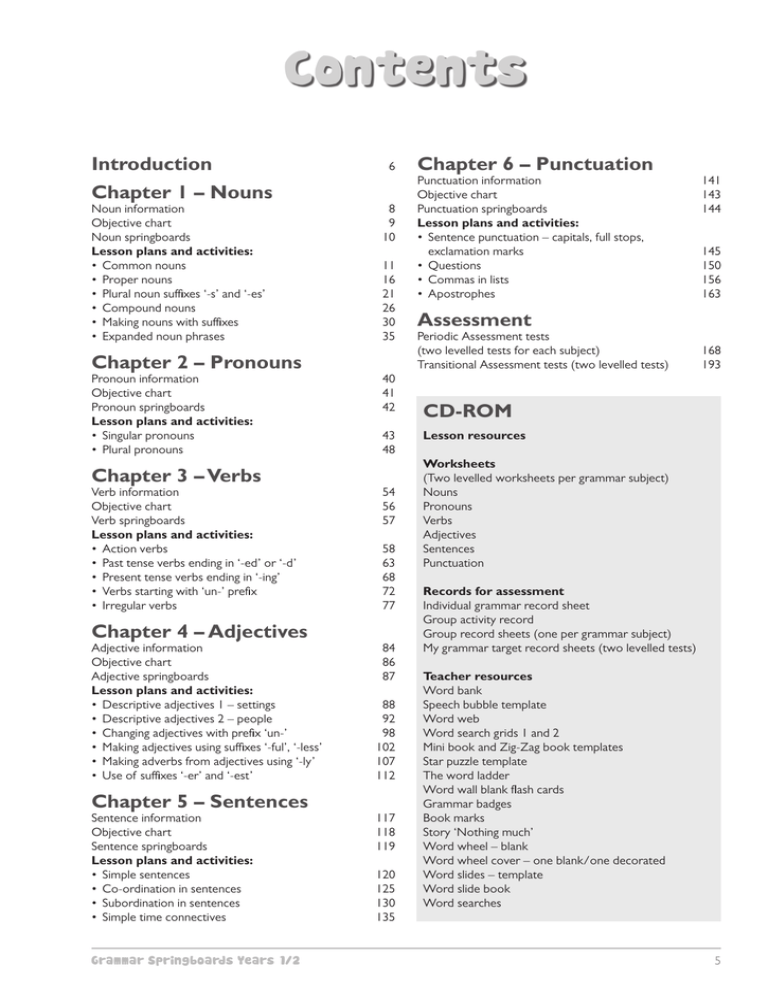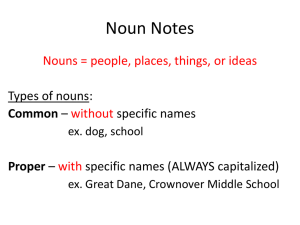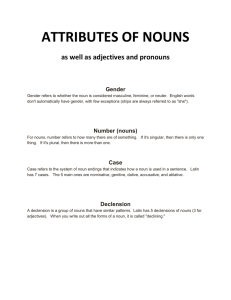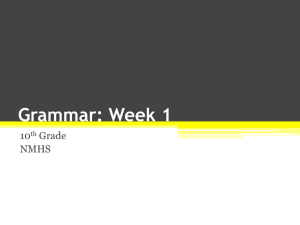Look Inside - Hopscotch Books
advertisement

Contents Introduction Chapter 1 – Nouns Noun information Objective chart Noun springboards Lesson plans and activities: • Common nouns • Proper nouns • Plural noun suffixes ‘-s’ and ‘-es’ • Compound nouns • Making nouns with suffixes • Expanded noun phrases Chapter 2 – Pronouns Pronoun information Objective chart Pronoun springboards Lesson plans and activities: • Singular pronouns • Plural pronouns Chapter 3 – Verbs Verb information Objective chart Verb springboards Lesson plans and activities: • Action verbs • Past tense verbs ending in ‘-ed’ or ‘-d’ • Present tense verbs ending in ‘-ing’ • Verbs starting with ‘un-’ prefix • Irregular verbs Chapter 4 – Adjectives Adjective information Objective chart Adjective springboards Lesson plans and activities: • Descriptive adjectives 1 – settings • Descriptive adjectives 2 – people • Changing adjectives with prefix ‘un-’ • Making adjectives using suffixes ‘-ful’, ‘-less’ • Making adverbs from adjectives using ‘-ly’ • Use of suffixes ‘-er’ and ‘-est’ Chapter 5 – Sentences Sentence information Objective chart Sentence springboards Lesson plans and activities: • Simple sentences • Co-ordination in sentences • Subordination in sentences • Simple time connectives Grammar Springboards Years 1/2 6 8 9 10 11 16 21 26 30 35 40 41 42 43 48 54 56 57 58 63 68 72 77 84 86 87 88 92 98 102 107 112 117 118 119 120 125 130 135 Chapter 6 – Punctuation Punctuation information Objective chart Punctuation springboards Lesson plans and activities: • Sentence punctuation – capitals, full stops, exclamation marks • Questions • Commas in lists • Apostrophes 141 143 144 145 150 156 163 Assessment Periodic Assessment tests (two levelled tests for each subject) Transitional Assessment tests (two levelled tests) 168 193 CD-ROM Lesson resources Worksheets (Two levelled worksheets per grammar subject) Nouns Pronouns Verbs Adjectives Sentences Punctuation Records for assessment Individual grammar record sheet Group activity record Group record sheets (one per grammar subject) My grammar target record sheets (two levelled tests) Teacher resources Word bank Speech bubble template Word web Word search grids 1 and 2 Mini book and Zig-Zag book templates Star puzzle template The word ladder Word wall blank flash cards Grammar badges Book marks Story ‘Nothing much’ Word wheel – blank Word wheel cover – one blank/one decorated Word slides – template Word slide book Word searches 5 There are three main sections to the book: Section 1 Section 1 is set out in chapters covering each of the main grammar areas – nouns, pronouns, verbs, adjectives, sentences, punctuation. Each chapter contains: Grammar information: Teacher information about the uses and different aspects of the grammar subject, including a glossary of terms, examples and word tables. Grammar and punctuation objective chart: A simple to read chart to show what grammar and punctuation objectives are covered in the grammar lessons and activities. Section 2: Assessment Periodic Assessment tests: Two levelled short tests to accompany each grammar chapter. The questions cover all the grammar areas taught in each chapter. Transitional Assessment tests: Two levelled transitional tests that can be used at the end of a school year to judge the progress and understanding of grammar subjects. Section 3: CD-ROM The accompanying CD-ROM contains resources which can be used on whiteboards, printed or photocopied. Ideas springboard: Fun ideas for wall displays, games and activities for the class, groups or individuals. Some resources for games and activities can be found in ‘Teacher resources’ – on the CD-ROM. Lesson resources: Include resources to accompany each of the lesson plans, including texts to highlight or re-model word and sentence examples, flashcards, information posters, games, templates for word sliders and pictures. Lesson plans: Suggested lesson plans for the different grammar subjects and objectives, e.g. ‘Chapter 1 – Nouns’ includes the subjects Common nouns, Proper nouns and Compound nouns. Worksheets: Stand alone worksheets for reinforcement, extension, homework and individual assessment. There are two levelled worksheets linked to each grammar subject covered within each chapter. Each lesson has a main teacher led lesson followed by differentiated activities for three ability groups. Records for assessment: • Individual Grammar Record Sheet: To be used during an activity for observing or assessing a child’s responses and understanding of the objective. Each lesson plan has: • Lesson objectives • Resources: list of suggested resources for the lesson and activities. Resources can be found in ‘Lesson resources’ on the CD-ROM. • Lesson/activity notes: Suggestions on setting up resources and suggested grouping and support for the activity groups. • Group Activity Record: To be used for writing observational notes and the children’s comments during a group activity. • Group Record Charts: To be used to record when certain children in a specific group have understood different learning objectives. • Main lesson: Teacher or adult led lesson with class participation. • My grammar target record sheet: A child’s own record sheet of achieving the learning objectives of the different grammar subjects. There is one sheet per grammar subject with a tick chart and a design to colour in as children achieve each objective. • Differentiated group activities: Three bullet point activities. Teacher resources: • Word bank • Plenary: Suggestions on ways to reinforce the lessons objectives. • Word searches and word search grid templates • Introduction: Ideas for introducing a grammar subject. • Templates for models and games • Support: Ideas for supporting children who may need more reinforcement or consolidation in their learning. • Definitions posters • Extension: Ideas and challenges for children who have grasped the main objectives and need to extend their knowledge. • Flash cards • Activity worksheets or resources: The activity worksheets are set out in age related abilities from Year 1 to end of Year 2. Word Bank: This useful resource can be used by teachers as a quick and easy reference or by children exploring different words and creating their own word banks. Grammar Springboards Years 1/2 • Fun grammar book marks and badges. 7 Noun springboards Noun ideas Collect catalogues, brochures and magazines that include examples of the four types of common nouns. Give a group of children one noun category such as ‘people’ and ask them to cut them out. Let them create labels and display their nouns with the labels as a display. Let the children research a noun category. For example they can discuss and find out more about people’s jobs and their titles, firefighter, doctor, teacher. A class noun list of the workers’ names can be added onto the board with labels and information about the jobs. Create graphs from a survey and pictures of the children’s favourite nouns of a category, e.g. favourite mini-beasts, favourite local places, favourite jobs and favourite food. Word walls Create eye catching word walls. One flash card equals one brick. Have several bricks to create the word wall with the children. Have blank cards so that the children can write new nouns and add to or make a new word wall shape. They can be used in a variety of ways. • Common and proper nouns: one wall per noun category, animals, objects, names of countries. Pass the book The children stand in the circle with a child in the middle with his or her eyes closed. The book is passed round the circle until the child in the middle claps. The child then says a letter of the alphabet. The child holding the book has to say four nouns/proper/plural/compound nouns (the noun subject is decided before the game starts) before the book is passed around the circle and ends up with them again. If the child does not manage to do it, he/she swaps places with the child in the middle. Matching compound nouns – Fox and geese Put the children into a circle. Number the children 1 and 2 alternately around the circle. Give all the 1s a beginning noun of a compound noun on a piece of paper. Give all the 2s the second parts of the compound nouns (the cards should be mixed up). Point to a child who is a number 1 and ask them to shout out their noun. A number 2 that has a noun that makes a compound noun calls out their noun. They jump up and try and chase each other around the circle and then sit down. Other activity ideas • I’m thinking of a noun. I’m acting a noun. I’m drawing a noun. • Making compound nouns. • Hangman. • Pairs such as single and plural nouns of a noun. • Team game when noun cards are put in the right category baskets – speed game. • Word wall for ‘an’ words and a word wall for ‘a’ words. The word ladder A similar game to ‘Consequences’. In groups of four the children are given strips of paper with four sections (see Word ladder template – Teacher resources). The children write a noun on the first section, fold over the paper to hide it and pass it to the next child. They then write another noun on the next and so on. After the strip has been completed, it is opened up and the children read out the four written nouns. • Common nouns: A child writes an example of a person noun, queen followed by an animal, place and object. They use the four nouns to orally tell a story. • Proper nouns: Choose four categories in advance and at the end the children use the nouns to tell a story or use the ideas to write a poem. Word wheel/ Word slide (see Teacher resources for templates) The teacher or children add nouns to the wheels or slides to explore and discover other words such as plurals with ‘-s’, compound nouns. Also a good reinforcement resource. 10 • Word searches – doing them and creating their own. • Creating fun nonsense compound nouns with drawings. • Use pictures and colouring books for the children to find nouns/more than one thing – plurals and get them to say or write a list down of what they see. • Kim’s game: Children look at a picture or a tray of objects before it is taken away. They write a list or say what they can remember. • Highlighting the proper names used on a simple local map. • Making a list of local shop names and designing their own shop display boards. • Fun compound nouns with fonts and colours and texts. • Happy common noun families/Happy proper noun families. • Matching Bingo – make noun base boards and matching noun cards. • Trump cards/Fact cards of noun categories. Grammar Springboards Years 1/2 Common nouns Learning objectives • To understand that common nouns name people, creatures, places and objects. Explain to the children that they are going to do common noun activities set round a summer fair. Put the children into their levelled groups and give out the activities. Spend time moving between the groups to discuss individual children’s work and assess their level of understanding. • To identify and use common nouns in sentences. Resources • Lesson – ‘Noun picture cards’ (Lesson resources CD-ROM). Copy the noun picture card sheets onto thin card and cut them into individual cards. Chapter 1, Common nouns, Activity 1 Green Street Summer Fair Name _____________________________________________________________________________ A common noun names people, places, things and animals, a boy, a house, a toy, a cat. • Group 1 (Year 1) – Copies of activity sheet 1, ‘Green Street Summer Fair’ for each child. Chapter 1, Common nouns, Activity 2 • Group 2 (Year 1/2) – Copies of activity sheet 2, ‘Fun at the Fair’ for each child. Fun at the Fair Name _____________________________________________________________________________ A common noun names people, places, things and animals, for example: a boy, a house, a toy, a cat. This is the Lucky Dip stall at the Green Street Summer Fair. Draw lines to match the labels to the Lucky Dip prizes. • Group 3 (Year 2) – Copies of activity sheet 3, ‘Panic at the Pet Show’ for each child. Lesson/activity notes • Lesson – Before the lesson, display the noun picture cards around the room. car bat ball • Group 2 (Year 1/2) – Children working individually on activity sheet and then with a partner or group to play a game. pen Chapter 1, Common nouns, Activity 3 The girl won a balloon. Panic at the Pet Show The boy has a kite. Grammar Springboards Years 1/2The dog got a bone. Name _____________________________________________________________________________ 13 Add your own noun to this sentence. • Group 1 (Year 1) – Children work as a discussion group with adult support. yo-yo Circle the two nouns in each sentence. A common noun names people, places, things and animals, for example: a boy, a house, a toy, a cat. The Pet Show atLucky Green Street I got a _____________________________ from the Dip box. Summer Fair is not going well. Add the nouns below to the sentences to find out what the pets did. Draw a picture of your noun. chicken hamster cat rabbit table bird bee cake hat nose tent string dog nest tree The d______________ ran after a b_________________ and got stung on the n________________ . The c_______________ saw a b____________________ and climbed up a t___________________. 14 Grammar Springboards Years 1/2 The h ____________ nibbled a s_____________________ and let a t____________________ down. The r_____________ jumped onto a t____________ and ate a large c________________________. • Group 3 (Year 2) – Children work individually on activity sheet and as pair–share with their work. The ch___________ saw a large h_________________ and made a cosy n_____________________. Choose another pet and make up a sentence about what they did at the pet show. _________________________________________________________________________________ Lesson _________________________________________________________________________________ _________________________________________________________________________________ _________________________________________________________________________________ Introduction At the beginning of the lesson, ask the children to look around the room for word and picture cards but not to tell the others what they can see. Explain that they are going to play ‘I-spy’ using the cards as subjects. Choose one child to start. When the correct answer is given, ask the child to bring up the card and then attach it to a board in front of the class. Once all the cards have been located and displayed, explain that all the words are common nouns. Main lesson Highlight that a common noun’s job is to name people, creatures, places and objects. Draw four columns on the white board and at the top of each column write: ‘People, Animals, Places, Objects’. With the children, sort the noun cards into the correct columns. Ask the children for a few more common noun examples and add them to the columns. Using a noun from each group, work with the children to write simple sentences. Do the first one as an example, ‘The boy fell over.’ Underline the noun. Grammar Springboards Years 1/2 Grammar Springboards Years 1/2 15 Activities Group 1 (Year 1) • Give out the activity sheet ‘ Green Street Summer Fair’ to each child. Remind the children what a common noun is and point to a couple of examples boy, ball. • Then the children look at the picture ‘Green Street Summer Fair’ to try and find twenty common nouns. • This can be done as a discussion group with the children taking turns to find and circle a noun on one copy of the picture, or individually with the children finding and circling the nouns on their own copies. • At the end of the task, look at the chosen nouns. Ask which ones are people, place, object or animal nouns. Record the children’s responses as they work. 11 Chapter 1, Common nouns, Activity 2 Fun at the Fair Name _____________________________________________________________________________ A common noun names people, places, things and animals, for example: a boy, a house, a toy, a cat. This is the Lucky Dip stall at the Green Street Summer Fair. Draw lines to match the labels to the Lucky Dip prizes. car bat ball yo-yo pen Circle the two nouns in each sentence. The girl won a balloon. The boy has a kite. The dog got a bone. Add your own noun to this sentence. I got a _____________________________ from the Lucky Dip box. Draw a picture of your noun. 14 Grammar Springboards Years 1/2 Chapter 1, Common nouns, Activity 3 Panic at the Pet Show Name _____________________________________________________________________________ A common noun names people, places, things and animals, for example: a boy, a house, a toy, a cat. The Pet Show at Green Street Summer Fair is not going well. Add the nouns below to the sentences to find out what the pets did. chicken hamster cat rabbit table bird bee cake hat nose tent string dog nest tree The d______________ ran after a b_________________ and got stung on the n________________ . The c_______________ saw a b____________________ and climbed up a t___________________. The h ____________ nibbled a s_____________________ and let a t____________________ down. The r_____________ jumped onto a t____________ and ate a large c________________________. The ch___________ saw a large h_________________ and made a cosy n_____________________. Choose another pet and make up a sentence about what they did at the pet show. _________________________________________________________________________________ _________________________________________________________________________________ _________________________________________________________________________________ _________________________________________________________________________________ Grammar Springboards Years 1/2 15 Periodic Assessment test 1– Punctuation Name: ___________________________________________________________________________ Date: ____________________________________________________________________________ Class: ____________________________________________________________________________ Level: ____________________________________________________________________________ 1. Add the missing capital letters and full stops to the sentences. a. on monday i like swimming b. on tuesday i like dancing c. on wednesday i like singing d. on thursday i like climbing e. on friday i like shopping f. on saturday i like riding What do you like doing on Sunday? I like _______________________________________________ 2. Add the question marks to the questions. a. What is your name b. How old are you c. Where do you live d. Who is your best friend e. When were you born 3. Draw a line to match the answers to the questions. What is a baby lion called? My birthday is in May. How many legs has a spider? An apple is green. Where is Big Ben? A baby lion is called a cub. Who was Mary Seacole? A spider has eight legs. When is your birthday? Big Ben is in London. Which is green, a carrot or an apple? Grammar Springboards Years 1/2 Mary Seacole was a nurse. 189





